A Usability Pilot Study of a Sensor-Guided Interactive System for Dexterity Training in Parkinson’s Disease
Abstract
1. Introduction
2. Materials and Methods
2.1. Recruitment and Participants
2.2. The Smart Sensor Egg System
2.3. Experimental Procedure
2.4. Evaluation
2.5. Statistical Analysis
3. Results
3.1. Demographic
3.2. Usability and Satisfaction
3.3. Algorithm Detection
4. Discussion
5. Conclusions
Supplementary Materials
Author Contributions
Funding
Institutional Review Board Statement
Informed Consent Statement
Data Availability Statement
Acknowledgments
Conflicts of Interest
Appendix A. Repetition Count Overview
| E1 | E2 | E3 | E4 | E5 | E6 | |||||||||||||
|---|---|---|---|---|---|---|---|---|---|---|---|---|---|---|---|---|---|---|
| Participant | TGT | ACT | DIFF | TGT | ACT | DIFF | TGT | ACT | DIFF | TGT | ACT | DIFF | TGT | ACT | DIFF | TGT | ACT | DIFF |
| PwPD1 | 17 | 17 | 0 | 19 | 20 | 1 | 21 | 21 | 0 | 6 | 1 | 5 | 25 | 25 | 0 | 23 | 23 | 0 |
| PwPD2 | 16 | 16 | 0 | 21 | 23 | 2 | 22 | 24 | 2 | 6 | 6 | 0 | 23 | 25 | 2 | 22 | 22 | 0 |
| PwPD3 | 20 | 25 | 5 | 19 | 23 | 4 | 23 | 24 | 1 | 4 | 0 | 4 | 27 | 27 | 0 | 23 | 23 | 0 |
| PwPD4 | 18 | 21 | 3 | 23 | 0 | 23 | 19 | 10 | 9 | 7 | 7 | 0 | 25 | 24 | 1 | 23 | 23 | 0 |
| PwPD5 | 17 | 17 | 0 | 28 | 27 | 1 | 26 | 38 | 12 | 7 | 7 | 0 | 24 | 26 | 2 | 24 | 24 | 0 |
| PwPD6 | 10 | 20 | 10 | 15 | 0 | 15 | 20 | 42 | 22 | 3 | 3 | 0 | 16 | 21 | 5 | 19 | 22 | 3 |
| PwPD7 | 0 | 0 | 0 | 0 | 0 | 0 | 22 | 39 | 17 | 5 | 2 | 3 | 31 | 31 | 0 | 23 | 23 | 0 |
| HS1 | 41 | 41 | 0 | 29 | 29 | 0 | 43 | 43 | 0 | 10 | 10 | 0 | 23 | 23 | 0 | 22 | 22 | 0 |
| HS2 | 24 | 24 | 0 | 42 | 42 | 0 | 36 | 43 | 7 | 5 | 5 | 0 | 29 | 29 | 0 | 29 | 29 | 0 |
| HS3 | 20 | 22 | 2 | 23 | 23 | 0 | 16 | 23 | 7 | 12 | 12 | 0 | 23 | 23 | 0 | 21 | 21 | 0 |
| HS4 | 15 | 15 | 0 | 27 | 27 | 0 | 31 | 27 | 4 | 13 | 13 | 0 | 23 | 23 | 0 | 25 | 25 | 0 |
| HS5 | 17 | 17 | 0 | 19 | 19 | 0 | 17 | 17 | 0 | 7 | 7 | 0 | 27 | 27 | 0 | 29 | 29 | 0 |
| HS6 | 17 | 17 | 0 | 21 | 22 | 1 | 16 | 18 | 2 | 6 | 0 | 6 | 25 | 25 | 0 | 18 | 19 | 1 |
| HS7 | 20 | 24 | 4 | 19 | 19 | 0 | 20 | 20 | 0 | 11 | 11 | 0 | 25 | 25 | 0 | 23 | 25 | 2 |
Appendix B. Example Signal

References
- Goldman, J.G.; Volpe, D.; Ellis, T.D.; Hirsch, M.A.; Johnson, J.; Wood, J.; Aragon, A.; Biundo, R.; Di Rocco, A.; Kasman, G.S.; et al. Delivering Multidisciplinary Rehabilitation Care in Parkinson’s Disease: An International Consensus Statement. J. Park. Dis. 2024, 14, 135–166. [Google Scholar] [CrossRef] [PubMed]
- Ben-Shlomo, Y.; Darweesh, S.; Llibre-Guerra, J.; Marras, C.; San Luciano, M.; Tanner, C. The epidemiology of Parkinson’s disease. Lancet 2024, 403, 283–292. [Google Scholar] [CrossRef] [PubMed]
- Bloem, B.R.; Okun, M.S.; Klein, C. Parkinson’s disease. The Lancet 2021, 397, 2284–2303. [Google Scholar] [CrossRef] [PubMed]
- van Munster, M.; Pedrosa, A.J.; Künkler, C.; Pedrosa, D.J. The Quality in Quality of Life in Parkinson’s Disease: A Qualitative Meta-Synthesis. Mov. Disord. Clin. Pract. 2024, 11, 761–769. [Google Scholar] [CrossRef] [PubMed]
- Tönges, L.; Buhmann, C.; Eggers, C.; Lorenzl, S.; Warnecke, T.; Bähr, M.; Becktepe, J.; Berg, D.; Brockmann, K.; Ceballos-Baumann, A.; et al. Guideline “Parkinson’s disease” of the German Society of Neurology (Deutsche Gesellschaft für Neurologie): Concepts of care. J. Neurol. 2024, 271, 7377–7386. [Google Scholar] [CrossRef]
- Radder, D.L.; Lígia Silva de Lima, A.; Domingos, J.; Keus, S.H.; van Nimwegen, M.; Bloem, B.R.; de Vries, N.M. Physiotherapy in Parkinson’s Disease: A Meta-Analysis of Present Treatment Modalities. Neurorehabilit. Neural Repair 2020, 34, 871–880. [Google Scholar] [CrossRef]
- Van Wegen, E.E.; Van Balkom, T.D.; Hirsch, M.A.; Rutten, S.; Van Den Heuvel, O.A. Non-Pharmacological Interventions for Depression and Anxiety in Parkinson’s Disease. J. Park. Dis. 2024, 14 (Suppl. s1), S135–S146. [Google Scholar] [CrossRef]
- Flynn, A.; Allen, N.E.; Dennis, S.; Canning, C.G.; Preston, E. Home-based prescribed exercise improves balance-related activities in people with Parkinson’s disease and has benefits similar to centre-based exercise: A systematic review. J. Physiother. 2019, 65, 189–199. [Google Scholar] [CrossRef]
- Vanbellingen, T.; Nyffeler, T.; Nigg, J.; Janssens, J.; Hoppe, J.; Nef, T.; Müri, R.M.; van Wegen, E.E.; Kwakkel, G.; Bohlhalter, S. Home based training for dexterity in Parkinson’s disease: A randomized controlled trial. Park. Relat. Disord. 2017, 41, 92–98. [Google Scholar] [CrossRef]
- Duncan, R.P.; Earhart, G.M. Remote Delivery of Allied Health Therapies in Parkinson’s Disease. J. Park. Dis. 2024, 14, S219–S226. [Google Scholar] [CrossRef]
- Bäckström, D.; Granåsen, G.; Domellöf, M.E.; Linder, J.; Mo, S.J.; Riklund, K.; Zetterberg, H.; Blennow, K.; Forsgren, L. Early predictors of mortality in parkinsonism and Parkinson disease A population-based study. Neurology 2018, 91, E2045–E2056. [Google Scholar] [CrossRef] [PubMed]
- Yang, Y.; Fu, X.; Zhang, H.; Ouyang, G.; Lin, S.C. The effect of home-based exercise on motor symptoms, quality of life and functional performance in Parkinson’s disease: A systematic review and meta-analysis. BMC Geriatr. 2023, 23, 873. [Google Scholar] [CrossRef] [PubMed]
- Pickering, R.M.; Fitton, C.; Ballinger, C.; Fazakarley, L.; Ashburn, A. Self reported adherence to a home-based exercise programme among people with Parkinson’s disease. Park. Relat. Disord. 2013, 19, 66–71. [Google Scholar] [CrossRef] [PubMed]
- Read, J.L.; Shortell, S.M. Interactive Games to Promote Behavior Change in Prevention and Treatment. JAMA 2011, 305, 1704–1705. [Google Scholar] [CrossRef] [PubMed]
- Smith, S.T.; Schoene, D. The Use of Exercise-Based Videogames for Training and Rehabilitation of Physical Function in Older Adults: Current Practice and Guidelines for Future Research. Aging Health 2012, 8, 243–252. [Google Scholar] [CrossRef]
- Sinclair, J.; Hingston, P.; Masek, M. Considerations for the design of exergames. In Proceedings of the GRAPHITE 2007, 5th International Conference on Computer Graphics and Interactive Techniques in Australasia and Southeast Asia, Perth, Australia, 1–4 December 2007; pp. 289–295. [Google Scholar] [CrossRef]
- Van Beek, J.J.; Van Wegen, E.E.; Bohlhalter, S.; Vanbellingen, T. Exergaming-Based Dexterity Training in Persons With Parkinson Disease: A Pilot Feasibility Study. J. Neurol. Phys. Ther. 2019, 43, 168–174. [Google Scholar] [CrossRef]
- Pirbabaei, E.; Amiri, Z.; Sekhavat, Y.A.; Goljaryan, S. Exergames for hand rehabilitation in elders using Leap Motion Controller: A feasibility pilot study. Int. J. Hum.-Comput. Stud. 2023, 178, 103099. [Google Scholar] [CrossRef]
- Carroll, D. Hand function in Parkinson’s disease. Md. Med J. 1967, 16, 171–173. [Google Scholar]
- Saric, L.; Knobel, S.E.; Pastore-Wapp, M.; Nef, T.; Mast, F.W.; Vanbellingen, T. Usability of Two New Interactive Game Sensor-Based Hand Training Devices in Parkinson’s Disease. Sensors 2022, 22, 6278. [Google Scholar] [CrossRef]
- Panyakaew, P.; Duangjino, K.; Kerddonfag, A.; Ploensin, T.; Piromsopa, K.; Kongkamol, C.; Bhidayasiri, R. Exploring the Complex Phenotypes of Impaired Finger Dexterity in Mild-To-moderate Stage Parkinson’s Disease: A Time-Series Analysis. J. Park. Dis. 2023, 13, 977–990. [Google Scholar] [CrossRef]
- Vanbellingen, T.; Nyffeler, T.; Nef, T.; Kwakkel, G.; Bohlhalter, S.; van Wegen, E.E. Reliability and validity of a new dexterity questionnaire (DextQ-24) in Parkinson’s disease. Park. Relat. Disord. 2016, 33, 78–83. [Google Scholar] [CrossRef] [PubMed]
- Carmeli, E.; Patish, H.; Coleman, R. The Aging Hand. J. Gerontol. Ser. A 2003, 58, M146–M152. [Google Scholar] [CrossRef] [PubMed]
- Proud, E.L.; Miller, K.J.; Morris, M.E.; McGinley, J.L.; Blennerhassett, J.M. Effects of Upper Limb Exercise or Training on Hand Dexterity and Function in People with Parkinson Disease: A Systematic Review and Meta-analysis. Arch. Phys. Med. Rehabil. 2024, 105, 1375–1387. [Google Scholar] [CrossRef] [PubMed]
- Foki, T.; Vanbellingen, T.; Lungu, C.; Pirker, W.; Bohlhalter, S.; Nyffeler, T.; Kraemmer, J.; Haubenberger, D.; Fischmeister, F.P.S.; Auff, E.; et al. Limb-kinetic apraxia affects activities of daily living in Parkinson’s disease: A multi-center study. Eur. J. Neurol. 2016, 23, 1301–1307. [Google Scholar] [CrossRef]
- Hughes, A.J.; Daniel, S.E.; Kilford, L.; Lees, A.J. Accuracy of clinical diagnosis of idiopathic Parkinson’s disease: A clinico-pathological study of 100 cases. J. Neurol. Neurosurg. Psychiatry 1992, 55, 181–184. [Google Scholar] [CrossRef]
- Julayanont, P.; Nasreddine, Z.S. Montreal Cognitive Assessment (MoCA): Concept and clinical review. In Cognitive Screening Instruments: A Practical Approach; Springer Nature: Berlin/Heidelberg, Germany, 2016; pp. 139–195. [Google Scholar]
- Brooke, J. SUS-A quick and dirty usability scale. Usability Eval. Ind. 1996, 189, 4–7. [Google Scholar]
- Sauro, J.; Lewis, J.R. Quantifying the User Experience: Practical Statistics for User Research; Morgan Kaufmann: Burlington, MA, USA, 2016; pp. 185–242. [Google Scholar]
- Bangor, A.; Kortum, P.T.; Miller, J.T. An Empirical Evaluation of the System Usability Scale. Int. J. Hum.–Comput. Interact. 2008, 24, 574–594. [Google Scholar] [CrossRef]
- R Core Team. A Language and Environment for Statistical Computing. Available online: https://www.R-project.org/ (accessed on 12 December 2024).
- Pastore-Wapp, M.; Kaufmann, B.C.; Nyffeler, T.; Wapp, S.; Bohlhalter, S.; Vanbellingen, T. Feasibility of a combined intermittent theta-burst stimulation and video game-based dexterity training in Parkinson’s disease. J. Neuroeng. Rehabil. 2023, 20, 2. [Google Scholar] [CrossRef]
- Lahude, A.B.; Souza Corrêa, P.; Maria, M.E.; Cechetti, F. The impact of virtual reality on manual dexterity of Parkinson’s disease subjects: A systematic review. Disabil. Rehabil. Assist. Technol. 2023, 18, 1237–1244. [Google Scholar] [CrossRef]
- Fellows, S.J.; Noth, J.; Schwarz, M. Precision grip and Parkinson’s disease. Brain 1998, 121, 1771–1784. [Google Scholar] [CrossRef]
- Chung, J.W.; Knight, C.A.; Bower, A.E.; Martello, J.P.; Jeka, J.J.; Burciu, R.G. Rate control deficits during pinch grip and ankle dorsiflexion in early-stage Parkinson’s disease. PLoS ONE 2023, 18, e0282203. [Google Scholar] [CrossRef] [PubMed]
- Abbruzzese, G.; Berardelli, A. Sensorimotor integration in movement disorders. Mov. Disord. Off. J. Mov. Disord. Soc. 2003, 18, 231–240. [Google Scholar] [CrossRef] [PubMed]
- Vanbellingen, T.; van Beek, J.; Nyffeler, T.; Urwyler, P.; Nef, T.; Bohlhalter, S. Tablet app-based dexterity-training in patients with Parkinson’s disease: Pilot feasibility study. Ann. Phys. Rehabil. Med. 2021, 64, 101419. [Google Scholar] [CrossRef] [PubMed]
- Proud, E.; Morris, M.E.; Bilney, B.; Miller, K.J.; Nijkrake, M.J.; Munneke, M.; McGinley, J.L. Hand dexterity assessment in Parkinson’s disease: Construct validity of the 9-Hole peg test for the more affected hand. Disabil. Rehabil. 2021, 43, 3834–3838. [Google Scholar] [CrossRef]
- Soke, F.; Ozcan Gulsen, E.; Erkoc Ataoglu, N.E.; Kocer, B.; Gulsen, C.; Turker, D.; Comoglu, S.S.; Bora Tokcaer, A. The coin rotation test: A reliable and valid test in people with Parkinson’s disease. Disabil. Rehabil. 2023, 45, 879–888. [Google Scholar] [CrossRef]
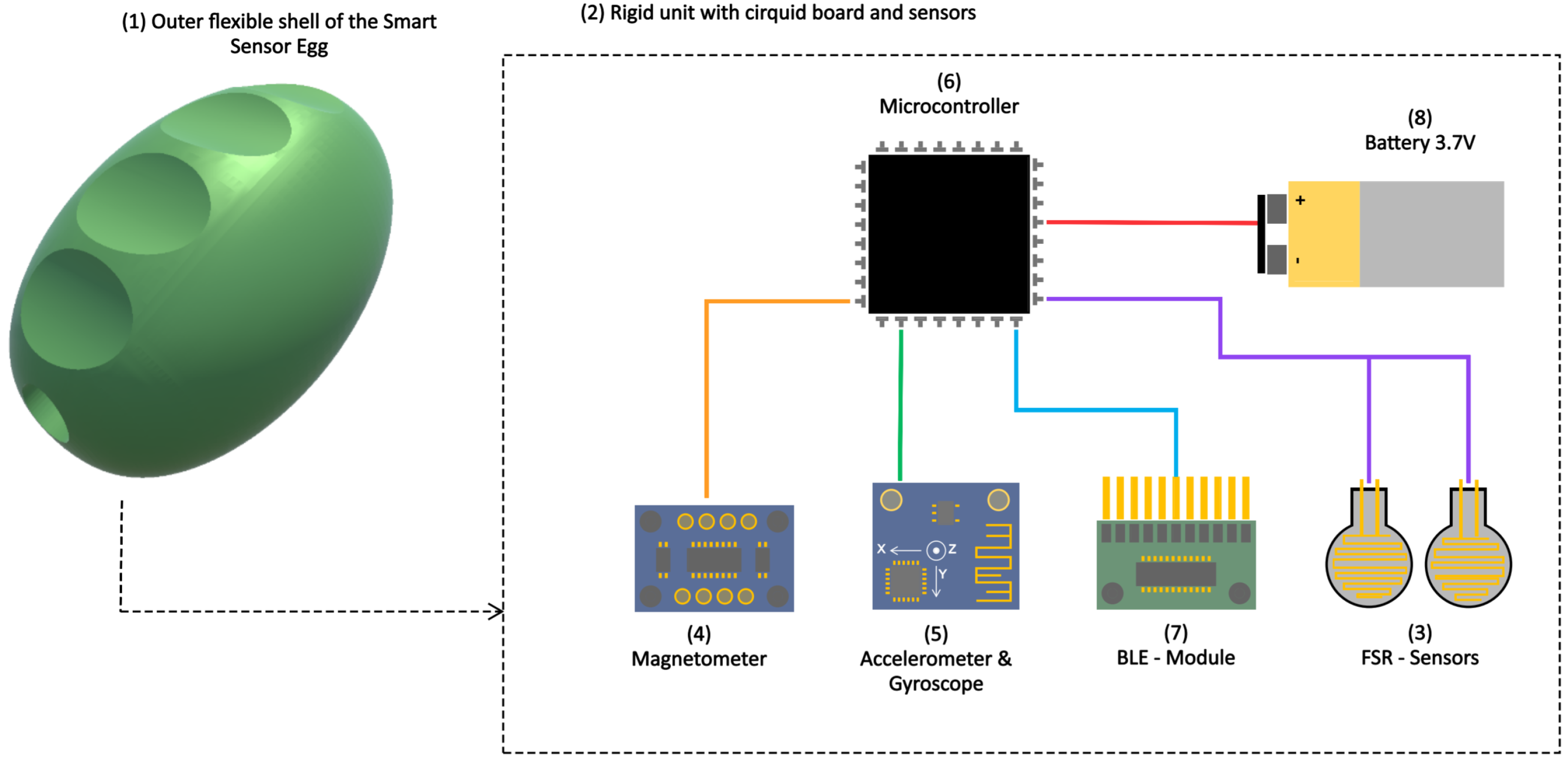
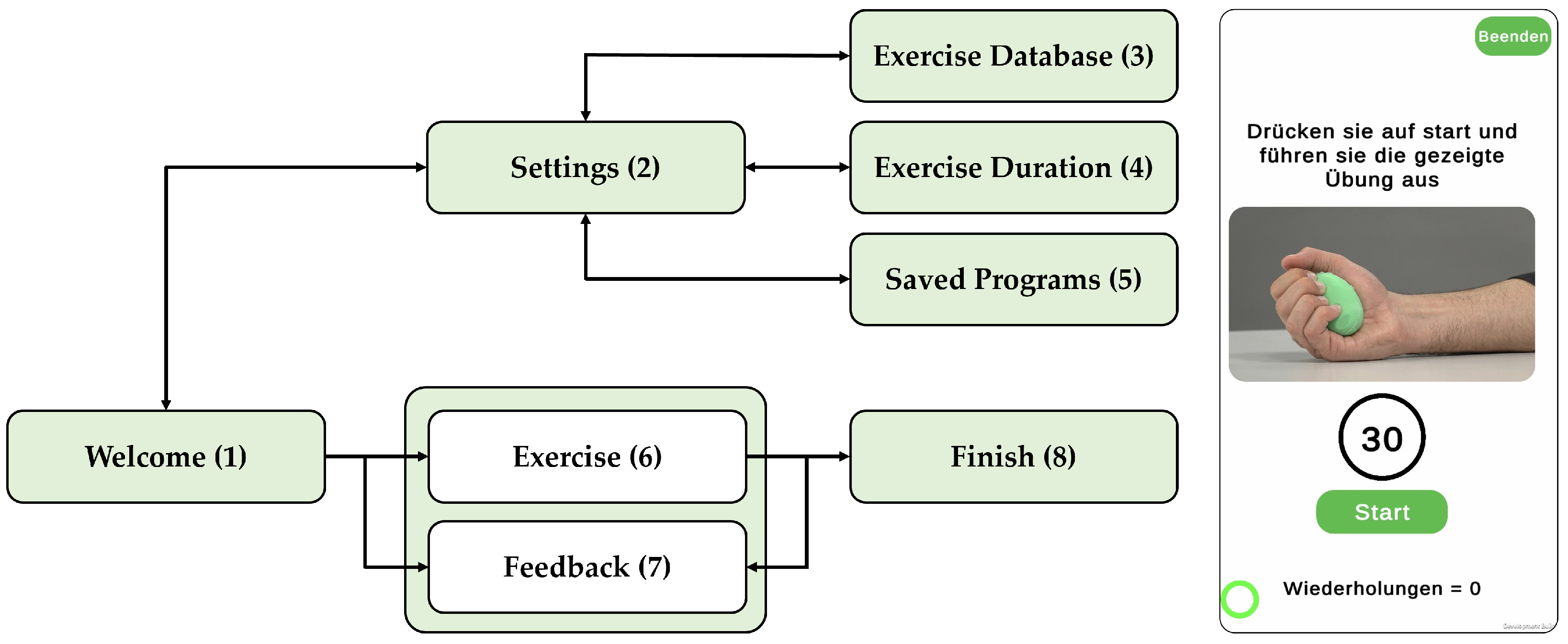
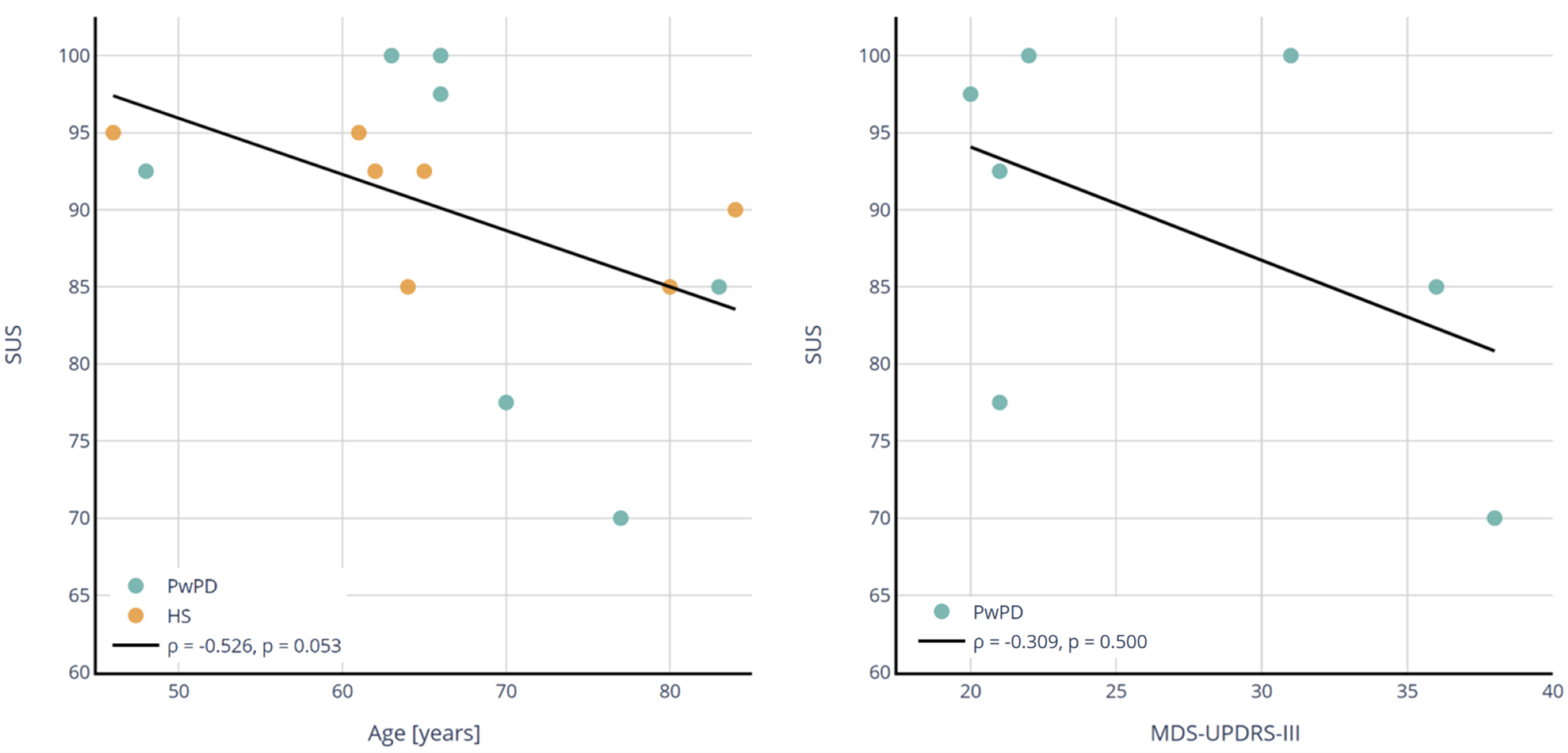
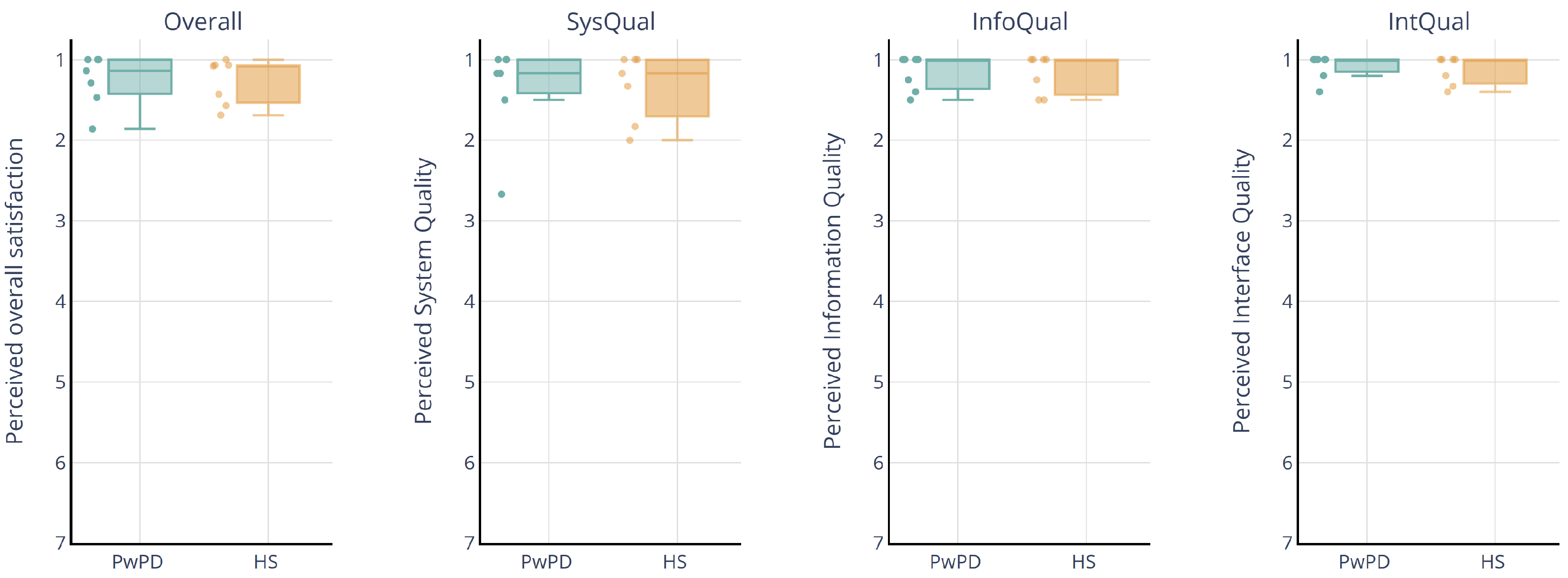
| Exercise | Image | Description | Sensor |
|---|---|---|---|
| 1 |  | Compression and release of the SSE with one hand | FSR |
| 2 |  | Compression and release of the SSE with the index finger | FSR |
| 3 |  | Compression and release of the SSE with the ring finger | FSR |
| 4 | 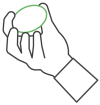 | Rotation of the SSE around the yaw axis with one hand | Gyroscope, Accelerometer |
| 5 | 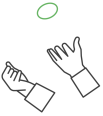 | Tossing and catching the SSE from one hand to the other | Accelerometer |
| 6 |  | Tossing and catching the SSE with one hand | Accelerometer |
| PwPD (n = 7) | HS (n = 7) | p-Value | |
|---|---|---|---|
| Age, y | 66 (64.5–73.5) | 64 (51.5–72.5) | 0.522 |
| Sex (m/f), n | 6/2 | 6/2 | 1.000 |
| MoCa 1 | 26 (26–27.5) | - | - |
| Disease duration, y | 4 (3.5–10) | - | - |
| MDS-UPDRS-III | 22 (21–33.5) | - | - |
| Hoehn and Yahr Stage | 2 (2–2.5) | - | - |
| Differenz | ||||||
|---|---|---|---|---|---|---|
| Participant | Exercise 1 | Exercise 2 | Exercise 3 | Exercise 4 | Exercise 5 | Exercise 6 |
| PwPD1 | - | 1 | - | 5 | - | - |
| PwPD2 | - | 2 | 2 | - | 2 | - |
| PwPD3 | 5 | 4 | 1 | 4 | - | - |
| PwPD4 | 3 | 23 | 9 | - | 1 | - |
| PwPD5 | - | 1 | 12 | - | 2 | - |
| PwPD6 | 10 | 15 | 22 | - | 5 | 3 |
| PwPD7 | - | - | 17 | 3 | - | - |
| HS1 | - | - | - | - | - | - |
| HS2 | - | - | 7 | - | - | - |
| HS3 | 2 | - | 7 | - | - | - |
| HS4 | - | - | 4 | - | - | - |
| HS5 | - | - | - | - | - | - |
| HS6 | - | 1 | 2 | 6 | - | 1 |
| HS7 | 4 | - | - | - | - | 2 |
Disclaimer/Publisher’s Note: The statements, opinions and data contained in all publications are solely those of the individual author(s) and contributor(s) and not of MDPI and/or the editor(s). MDPI and/or the editor(s) disclaim responsibility for any injury to people or property resulting from any ideas, methods, instructions or products referred to in the content. |
© 2025 by the authors. Licensee MDPI, Basel, Switzerland. This article is an open access article distributed under the terms and conditions of the Creative Commons Attribution (CC BY) license (https://creativecommons.org/licenses/by/4.0/).
Share and Cite
Krummenacher, N.; Gerber, S.M.; Pastore-Wapp, M.; Single, M.; Bohlhalter, S.; Nef, T.; Vanbellingen, T. A Usability Pilot Study of a Sensor-Guided Interactive System for Dexterity Training in Parkinson’s Disease. Sensors 2025, 25, 1051. https://doi.org/10.3390/s25041051
Krummenacher N, Gerber SM, Pastore-Wapp M, Single M, Bohlhalter S, Nef T, Vanbellingen T. A Usability Pilot Study of a Sensor-Guided Interactive System for Dexterity Training in Parkinson’s Disease. Sensors. 2025; 25(4):1051. https://doi.org/10.3390/s25041051
Chicago/Turabian StyleKrummenacher, Nic, Stephan M. Gerber, Manuela Pastore-Wapp, Michael Single, Stephan Bohlhalter, Tobias Nef, and Tim Vanbellingen. 2025. "A Usability Pilot Study of a Sensor-Guided Interactive System for Dexterity Training in Parkinson’s Disease" Sensors 25, no. 4: 1051. https://doi.org/10.3390/s25041051
APA StyleKrummenacher, N., Gerber, S. M., Pastore-Wapp, M., Single, M., Bohlhalter, S., Nef, T., & Vanbellingen, T. (2025). A Usability Pilot Study of a Sensor-Guided Interactive System for Dexterity Training in Parkinson’s Disease. Sensors, 25(4), 1051. https://doi.org/10.3390/s25041051








